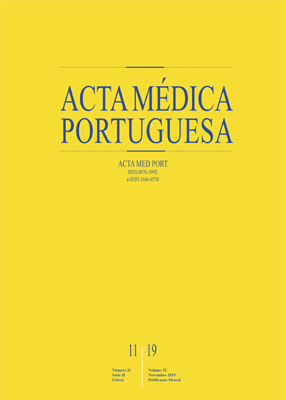Recém-Nascido de Muito Baixo Peso numa Unidade de Cuidados Intensivos Portuguesa Comparativamente ao Vermont Oxford Network: 15 Anos de Registo
DOI:
https://doi.org/10.20344/amp.9130Palavras-chave:
Benchmarking, Mortalidade Infantil, Recém-Nascido de Peso Extremamente Baixo ao Nascer, Recém-Nascido de Muito Baixo Peso, Unidades de Cuidados Intensivos NeonataisResumo
Introdução: O nosso serviço de Neonatologia está integrado num hospital perinatal diferenciado e pertence à rede de registo Vermont Oxford Network desde há mais de 15 anos. Este registo inclui dados da morbi-mortalidade de recém-nascidos com peso de nascimento entre 401 e 1500 g e/ou das 22 às 29 semanas e seis dias de gestação, nascidos nos hospitais membros ou admitidos até aos 28 dias de vida. Permite a análise da prática clínica e comparação com unidades semelhantes. Foi nosso objetivo divulgar alguns dos nossos dados dos últimos 15 anos fazer a sua reflexão, o estudo dos resultados e evolução das práticas assistenciais neonatais ao longo dos anos, e compará-los com os dados de um grupo com o mesmo nível de cuidados da rede Vermont Oxford Network. Dado considerarmos ser fundamental o estudo dos dados de morbimortalidade das unidades de neonatologia e sua comparação com unidades congéneres no sentido de identificação de áreas suscetíveis de intervenção, consideramos a pertinência da divulgação dos nossos dados.
Material e Métodos: Estudo observacional, retrospetivo. Incluídos recém-nascidos com peso de nascimento ≤ 1500 g (recém-nascido de muito baixo peso) nascidos e tratados no nosso Hospital de 2001 a 2015 e comparados em dois subgrupos temporais com os dados da rede Vermont Oxford Network. Análise dos dados descritiva, teste de qui-quadrado e ANOVA, significância quando p < 0,05.
Resultados: Estudaram-se 869 recém-nascidos de muito baixo peso com uma mediana de peso 1100 g e idade gestacional 29 semanas. Eram gémeos 37,6%. Na sala de partos 23% não necessitaram de qualquer reanimação, precisaram de entubação endotraqueal 52,2% dos recém-nascidos, em 78,3% foi administrado surfactante e desde que tal começou a ser registado em 2011, 29,7% iniciaram de imediato ventilação não invasiva. Em relação às principais morbilidades estudadas do ponto de vista respiratório do total de recém-nascidos de muito baixo peso 12,9% tinham oxigenoterapia às 36 semanas de idade corrigida, em relação à persistência do canal arterial hemodinamicamente significativo esta verificou-se em 23% e do ponto de vista infecioso verificou-se sépsis tardia em 17,1%. Registámos maior morbilidade neurológica comparativamente à Vermont Oxford Network exceto na retinopatia da prematuridade. A mortalidade global foi de 14% (122 recém-nascidos). O tempo de internamento foi em média de 52,7 ± 34,4 dias. Os 629 recém-
‑nascidos que tiveram alta para o domicílio estiveram internados sensivelmente os mesmos dias e apresentavam valores semelhantes de perímetro cefálico, mas menor peso no dia da alta que os da rede Vermont Oxford Network, tendo tido alta da nossa unidade com aleitamento materno exclusivo 14,3% dos recém-nascidos de muito baixo peso.
Discussão: Este trabalho permitiu fazer a reflexão sobre os dados do nosso serviço de Neonatologia e compará-los com os de um dos maiores registos neonatais mundiais. Verificámos que a nossa população de recém-nascidos de muito baixo peso é muito sobreponível do ponto de vista da idade gestacional e somatométrico, taxas de vigilância da gravidez e de cesarianas, sendo a diferença mais notória a percentagem de leves para a idade gestacional, de gestações gemelares e de realização de indução maturativa que foram superiores no nosso centro. As patologias do foro cardiorrespiratório e gastrointestinais foram sobreponíveis. Verificámos que é urgente melhorar a taxa de infeção associada aos cuidados de saúde, das sequelas neurológicas, do controle da hipotermia após o nascimento e da neuroprotecção com sulfato de magnésio. A taxa de mortalidade foi sobreponível assim como o tempo de internamento.
Conclusão: Este trabalho permitiu-nos comparar a nossa população de recém-nascidos de muito baixo peso com os registados na rede. Verificámos que acompanhámos a evolução que a Neonatologia foi tendo ao longo dos anos e identificámos áreas suscetíveis de melhoria.
Downloads
Downloads
Publicado
Como Citar
Edição
Secção
Licença
Todos os artigos publicados na AMP são de acesso aberto e cumprem os requisitos das agências de financiamento ou instituições académicas. Relativamente à utilização por terceiros a AMP rege-se pelos termos da licença Creative Commons ‘Atribuição – Uso Não-Comercial – (CC-BY-NC)’.
É da responsabilidade do autor obter permissão para reproduzir figuras, tabelas, etc., de outras publicações. Após a aceitação de um artigo, os autores serão convidados a preencher uma “Declaração de Responsabilidade Autoral e Partilha de Direitos de Autor “(http://www.actamedicaportuguesa.com/info/AMP-NormasPublicacao.pdf) e a “Declaração de Potenciais Conflitos de Interesse” (http://www.icmje.org/conflicts-of-interest) do ICMJE. Será enviado um e-mail ao autor correspondente, confirmando a receção do manuscrito.
Após a publicação, os autores ficam autorizados a disponibilizar os seus artigos em repositórios das suas instituições de origem, desde que mencionem sempre onde foram publicados e de acordo com a licença Creative Commons









